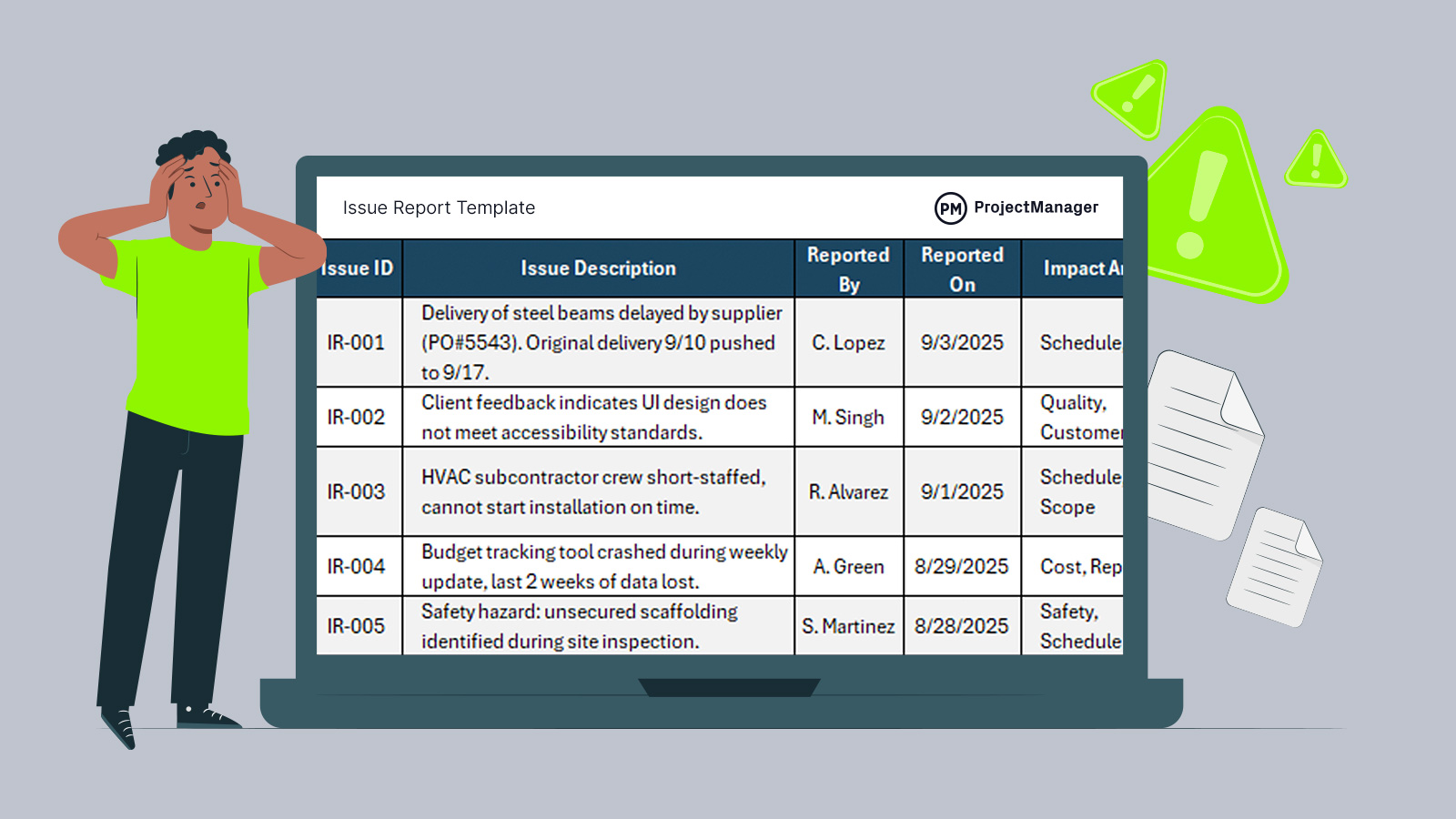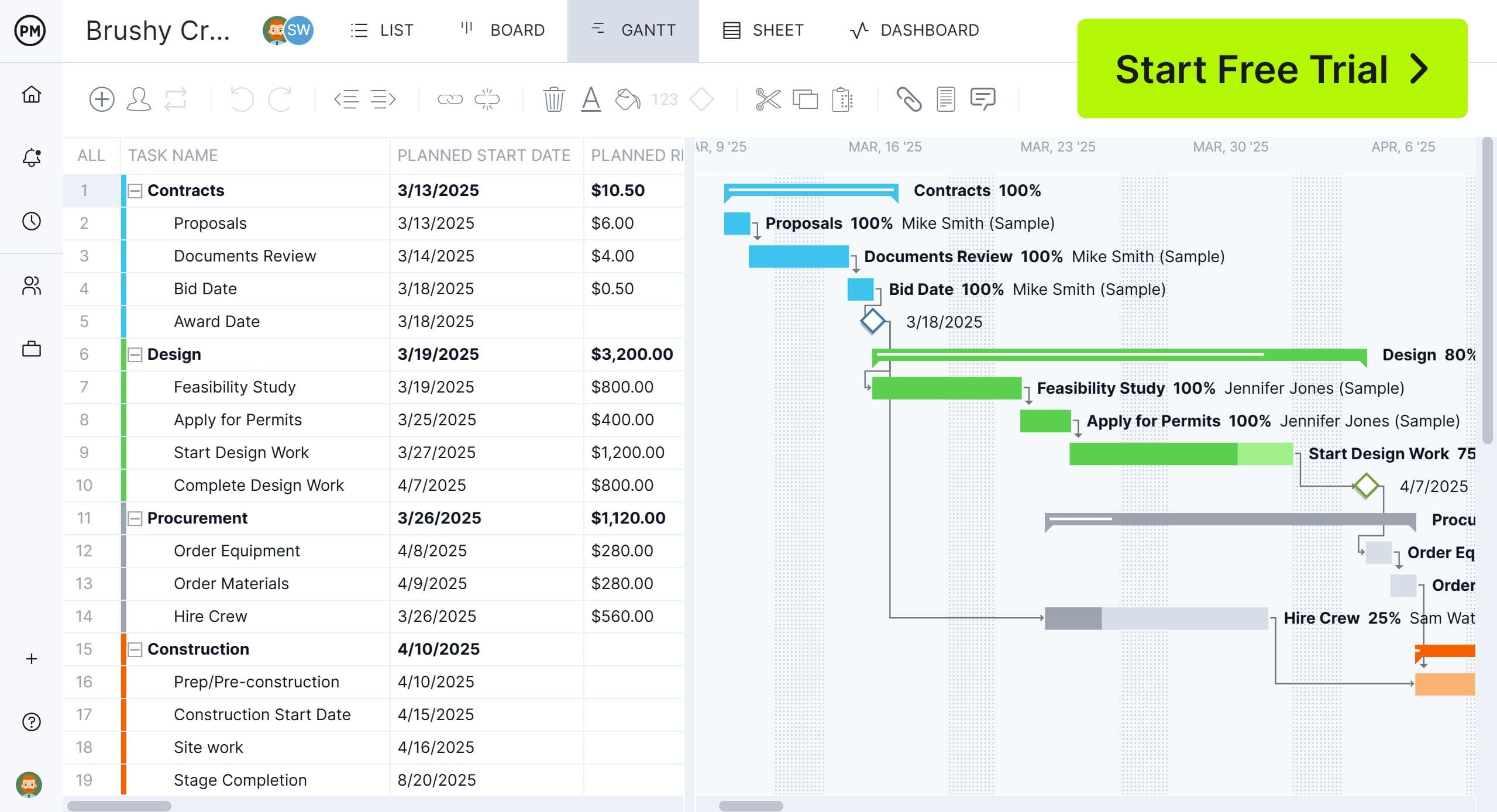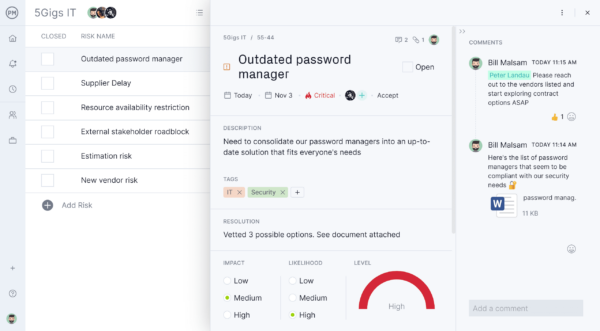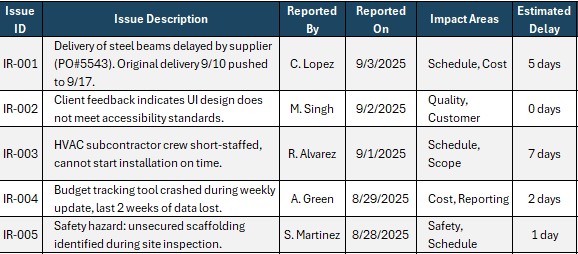Every project encounters challenges along the way. Whether it is unexpected delays, resource shortages or technical hurdles, issues can derail progress if they are not handled quickly. Teams that rely on structured reporting are better prepared to respond to problems, resolve them faster and keep projects on track. This makes issue report project management an important practice for maintaining momentum and avoiding costly disruptions.
Creating and using an issue report gives teams a consistent way to document, track and address obstacles throughout the project life cycle. With a clear process in place, project managers can assign accountability, prioritize urgent matters and keep stakeholders informed. The following guide explores how to make an effective issue report for project management, complete with a practical example and a ready-to-use template.

Get your free
Issue Report Template
Use this free Issue Report Template to manage your projects better.
Get the Template
What Is an Issue Report?
An issue report is a structured document that captures problems or obstacles that arise during a project. It provides key details such as the description of the issue, its impact on the project, the person responsible for resolving it and any deadlines for corrective action. By standardizing how issues are recorded, teams ensure nothing slips through the cracks and project managers can address problems systematically rather than reactively.
In project management, issue reports also serve as a communication tool between team members and stakeholders. They offer transparency into current challenges, highlight potential risks to project delivery and establish accountability for resolution. This creates a shared understanding of priorities and allows teams to focus their energy on solutions instead of spending time debating the problem itself.
While issue reports can be created manually, project management software makes the process faster and more reliable. With centralized tools, issues can be logged in real time, automatically assigned to the right team member and tracked through dashboards. This not only streamlines documentation but also ensures project leaders have visibility into how issues affect timelines, budgets and resource availability.
ProjectManager is especially well-suited for issue report project management because it combines collaborative tools with powerful tracking features. Teams can create tasks to represent issues, assign owners, set deadlines and monitor resolution progress through customizable dashboards. With Gantt charts, kanban boards and workload management features, Our software ensures that issues are not only documented but actively resolved within the larger project plan. Get started with ProjectManager today for free.

When to Make an Issue Report
An issue report should be created when a problem arises that threatens to delay, derail or disrupt a project. This could include technical problems, missed deadlines, budget overruns, resource shortages or unexpected changes in scope. Recording the issue early helps ensure it is tracked and addressed before it escalates into a larger setback. The sooner the issue is logged, the easier it is for managers and teams to assess its impact and assign corrective actions.
Another good time to make an issue report is when risks identified during planning actually materialize. For example, if a supplier fails to deliver materials on schedule or a piece of equipment breaks down, an issue report gives the team a clear record of what happened and what actions need to be taken. Reports should also be made if recurring issues keep surfacing, since documenting them helps identify patterns and root causes. In short, issue reports should not be reserved only for major crises but used consistently whenever a problem could affect project success.
Why Is It Important to Make an Issue Report for a Project?
An issue report is important because it provides a structured way to capture problems that could affect the project outcome. Without clear documentation, issues can get overlooked or forgotten, leading to delays and added costs. Recording issues in a report ensures that everyone on the team is aware of the problem, understands its impact and knows who’s responsible for resolving it. This creates accountability and prevents confusion about ownership or next steps.
Issue reports also serve as a valuable communication tool between team members, managers and stakeholders. They provide a central reference point that tracks the history of the issue, the actions taken and the results. This transparency not only helps in resolving the current issue but also builds a knowledge base for future projects. By identifying recurring problems or bottlenecks, teams can implement long-term improvements that increase efficiency and reduce risks across all projects.

What Should Be Included in an Issue Report?
An issue report needs to be clear and detailed enough so that anyone reviewing it can understand the problem, its impact and the steps required to address it. While formats can vary depending on the project or industry, the following elements are generally essential for creating a complete and actionable issue report.
- Issue ID & Title: A simple reference number and a short name so the issue can be tracked and discussed easily.
- Reported by (and date): Notes who found the issue and the date when it was first recorded, to keep accountability clear.
- Project Phase and Related Task: Shows exactly where in the project plan the issue belongs, so it’s easier to connect it to the right work.
- Description: A clear summary of what went wrong, where it happened and any useful details for understanding it.
- Impact Areas: Explains which parts of the project are affected, such as schedule, budget, quality, safety or customer expectations.
- Severity and Priority: Severity tells how serious the impact is, while priority shows how urgently it needs attention.
- Owner: Names the person responsible for following through until the issue is resolved.
- Mitigation Actions: The issue report captures what was done to control the issue quickly, how it will be properly fixed, and how to avoid it in the future.
- Status: Shows the current state of the issue, like open, in progress, blocked, resolved, or closed.
- Evidence and Attachments: Adds supporting files, such as screenshots, photos, logs or purchase orders, that help explain the problem.
- Affected Deliverables, Location and Environment: Specifies which product, document, site or environment is directly impacted.
- Is Work Blocked? Says whether this issue is stopping progress right now and what is being held up.
- Estimated Delay: Provides the best estimate of how much the schedule will be pushed back.
- Estimated Cost Impact: Gives an idea of any extra costs that may result, either as a number or a rough range.
- Stakeholders Notified and Approver: Lists who has been told about the issue and who needs to sign off on major actions.
- Root Cause and Contributing Factors: Explains the main reason the issue occurred and any other details that made it worse.
- Related Items: Links the issue to related records like change requests, risks, dependencies or contracts.
- Resolution Category: States how the issue was ultimately closed—whether through a fix, a workaround, or by accepting the change.
- Verification & Close Date: Records when the solution was checked and the issue was officially closed.
- Lessons Learned: Summarizes one key takeaway that can help prevent similar issues later.
Issue Report Template
Download this free issue report template to capture, track and resolve problems as they arise. By using a standardized format, project managers can make sure that each issue includes critical details such as a unique ID, description, impact areas and severity. This consistency improves communication between team members and stakeholders because everyone has the same reference points and knows where to find information. It also ensures accountability by clearly assigning an owner to each issue and recording who reported it and when. Having these details in one place streamlines discussions and helps teams move toward solutions faster.

Beyond tracking the issue itself, a good issue report template also supports long-term improvement. Fields such as root cause analysis, mitigation actions and lessons learned allow organizations to not only fix immediate problems but also prevent them from recurring.
Including space for attachments, related items and resolution categories makes the report more comprehensive and easier to connect with other project records. When used consistently, the template becomes a valuable tool for project governance, improving transparency and decision-making while reducing the risk of overlooked or poorly managed issues.
Issue Report Example
To better understand what an issue report looks like in practice, let’s walk through a simple example. The table below illustrates how project teams can log and track different types of issues—from supplier delays and design problems to safety hazards and system failures.

Each entry captures the essential details, such as who reported the issue, when it was logged, the potential impact on the project, and the actions taken to resolve it. By documenting issues in this structured way, project managers can quickly assess risks, assign ownership and monitor progress toward resolution.

More Free Project Management Templates
Project management is easier when you have ready-made tools to capture risks, issues and plans. Below are some useful free templates that can help you stay organized and keep projects on track.
Risk Register Template
This template helps teams identify potential risks, assess their likelihood and impact, and create response plans. It provides a clear record to monitor risks throughout the project.
Issue Tracking Template
Use this template to log project issues, assign ownership and track progress until resolution. It standardizes issue reporting and ensures accountability across the team.
Risk Management Plan Template
This template outlines how risks will be managed during a project. It defines risk strategies, responsibilities and monitoring processes to reduce uncertainty and improve decision-making.
ProjectManager Is Better Than an Issue Report
While an issue report is a valuable tool for documenting and tracking problems, it is limited in scope. It captures information at a single point in time but doesn’t provide the visibility, automation or collaboration features needed to manage complex projects. ProjectManager goes beyond a static report by connecting issue tracking to every other part of project execution, making it a more complete solution.
Streamline Collaboration and Accountability
ProjectManager allows teams to comment directly on tasks, share files and get real-time updates across multiple project views, eliminating the delays that come from relying on manual issue reports. Whether working on Gantt charts, task lists, kanban boards, sheet or calendar views, notifications and alerts ensure accountability by letting everyone know when an issue is updated or when action is required, which keeps work moving without bottlenecks.

Track and Resolve Issues With Live Data
Instead of reviewing static issue logs, managers can use our real-time dashboards, Gantt charts and workload views to see how issues affect timelines, resources and budgets in real time. This visibility helps prioritize responses, allocate staff efficiently and track the progress of resolutions so issues are not just recorded but actively managed until closed.
Related Issue Management Content
An issue report in project management is only a part of the larger issue management process. For those who care to learn more about this topic, below are some recently published articles on tracking software, issue logs and more.
- 10 Best Issue Tracking Software for Project Management
- What Is an Issue Log? Templates & Tips
- Issue Management Process in Project Management
- The Risk Management Process in Project Management
- How to Make a Risk Management Plan (Template Included)
- Project Risk Analysis: Quantitative & Qualitative Techniques
ProjectManager is online project and portfolio management software that connects teams, whether they’re in the office or out in the field. They can share files, comment at the task level and stay up to date with email and in-app notifications. Get started with ProjectManager today for free.

